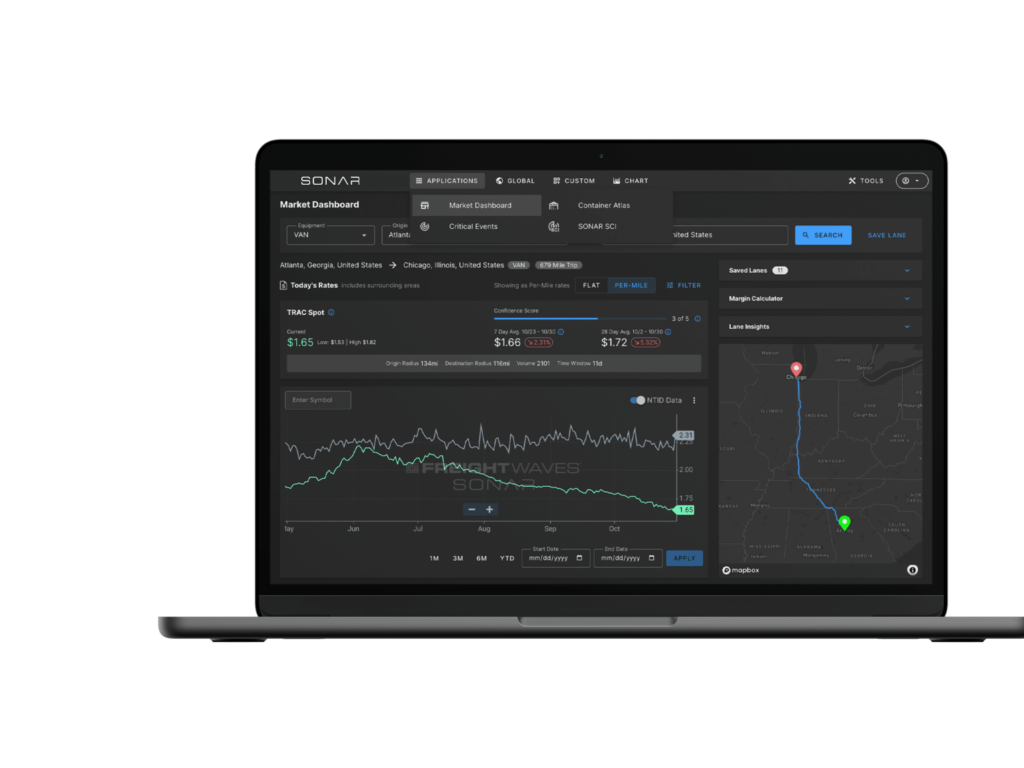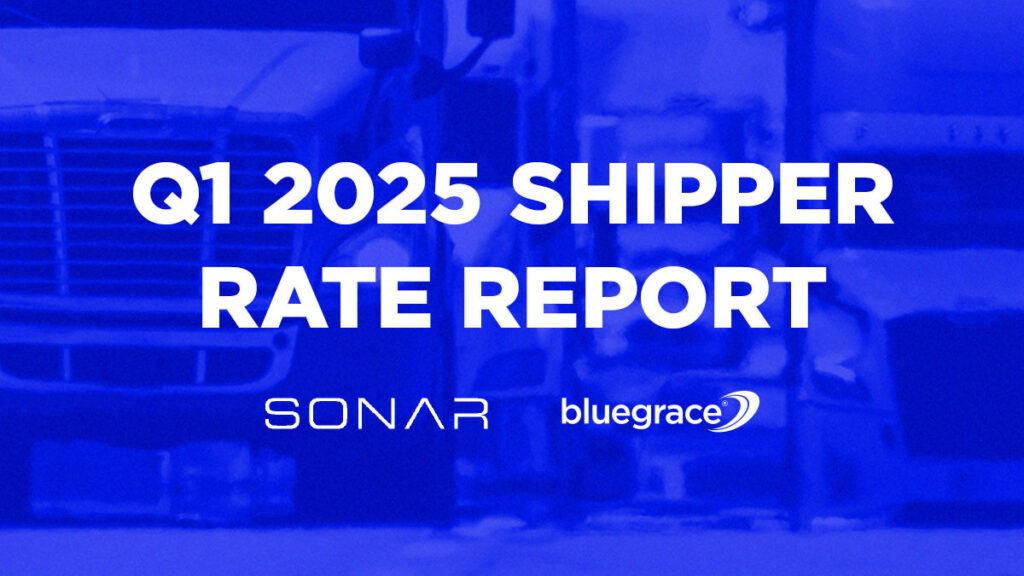FedEx highlights risks that could keep freight markets looser for longer
This week’s SONAR Pricing Power Index (PPI): 40 (market favors shippers in general; unchanged from last week)
3-month SONAR Pricing Power Index Outlook: 45 (market slightly favors shippers; unchanged from last week)
About the SONAR PPI: The SONAR Pricing Power Index is a qualitative assessment of the balance of negotiating power between shippers and carriers on a scale from 0 to 100 using SONAR data and anecdotes from discussions with SONAR clients. The higher the number, the tighter the freight market and the more that pricing power favors carriers. A 50 represents a balanced market. While the SONAR PPI primarily pertains to the truckload sector given its size, dynamics in other sectors, such as intermodal and ocean, are also considered.
For additional detail on the PPI, I discuss the rationale behind the SONAR Pricing Power Index rating on The Stockout show live each Monday at 9 a.m. ET on FreightWaves.com. Replays are available via The Stockout YouTube Page here.
The week of the Fed and FedEx
The past week saw continued volatility in the stock market (at least in both directions this time), and both the Fed and FedEx acknowledged emerging economic concerns they had not fully seen or appreciated earlier. Specifically, FedEx reduced full-year earnings guidance by 6%, driven by economic uncertainty slowing consumer and parcel demand, softness in the industrial economy, a shift in mix toward lower-margin deferred shipments, and cost inflation. Part of that cost inflation was for purchased transportation costs, which, in theory, could be a positive note for the overall freight market. But it’s not clear how much of that was due to changes in FedEx’s network.

(Chart: Yahoo! Finance)
In contrast to the heavy news week, there were few changes to recent trends in SONAR, which had already been showing volume softness the past several weeks. Therefore, the PPI remains unchanged for now at 40 with pricing power continuing to favor shippers.
Tender volume continues to track with levels from 2 years ago

2025 tender volume (white line) declined from January to February before trending in line with 2023 levels in March. (Chart: SONAR)
The SONAR Outbound Tender Volume Index, which measures the frequency of requests from shippers to move loads on the highway, is trending right in line with 2023 levels and down 8.5% year over year. It is up 0.7% in the past week and 0.8% from two years ago.
If the recent pattern and typical seasonal trends hold, SONAR tender volume will trend lower in the upcoming few weeks since April is typically a weak month seasonally. Uncertainty related to tariffs and the macroeconomy could exacerbate that trend.
The 8.5% year-over-year decline in overall tender volume breaks down to a 3.9% decline for the reefer segment and 10.7% decline for dry van. Dry van demand has been more volatile than reefer demand because a larger portion of dry van freight is discretionary and economically sensitive. In addition, the weakness in dry van volume can be partially attributed to market share gain by rail intermodal in certain dense corridors where intermodal has a significant cost advantage. Dry van freight volume will likely show a significant uptick in May when summer merchandise, much of which is bulky, is moved from warehouses to locations close to the point of consumption.
Tender rejection rate settles in at 5.7%

The national tender rejection rate jumped in early March but has since settled into a level roughly in line with February. (Chart: SONAR)
The Outbound Tender Reject Index, a measure of relative tightness in truckload capacity, is essentially unchanged from one week ago and is 194 basis points above year-ago levels, suggesting the freight market is closer to being in balance than it was this time last year. Still, a 5.7% overall tender rejection rate is not an indication of widespread capacity tightness; instead, any tightness has been limited to certain geographies and equipment types.
What’s most notable about the current tender rejection rate is that it is above year-ago levels on freight volume, which is below year-ago levels. In addition, in recent months, the tender rejection rate has become more sensitive to events that temporarily reduce available capacity levels, such as holidays or winter storms. That reflects a freight market where transportation capacity continues to exit rapidly and that capacity reduction has had a greater impact on the market than the decline in tender volume over the same period. However, for widespread tightness to be felt, it may have to come at a seasonally strong time of the year. Freight demand this March has been generally disappointing. April is typically a lackluster month for freight demand. That leaves May, when we could see a diminished supply and hopefully solid demand come together, resulting in market tightness that is widespread rather than concentrated in certain locations (often involving significant out-of-route miles) and equipment types (often specialized), as it is now. A more significant pullback in demand, which may include a consumer-driven recession, appears to be the main risk to the view that capacity may tighten later this year.

Driven by tariff uncertainty, the U.S. flatbed tender rejection rate (yellow line) has been the most volatile component of the overall tender rejection rate. Meanwhile, the dry van (white) and reefer (red) tender rejection rates have generally trended flat to down. (Chart: SONAR)
Like rejection rates, spot rates remain higher than year-ago levels

Average spot rates, adjusted for changes in fuel prices, remain above year-ago levels, driven by rising rates to go into out-of-route locations. (Chart: SONAR)
The SONAR National Truckload Index, an aggregate of spot rates with the impact of fuel removed, shows a decline in rates that is very consistent with the pattern of the past two years – declining in the early months of the year. The fuel-adjusted spot rates shown in the chart above are down 1 cent from the prior week and are 2.4% higher year over year. Going forward, spot rates should continue to trend in a manner similar to the tender rejection rate since chasing more highly rated loads on the spot market is the main reason for carriers to reject shippers’ requests to move loads.
Rail intermodal volume has grown while truckload volume has declined

Relative to last year, international intermodal volume (white) and domestic intermodal volume (red) outperformed long-haul truckload tender volume (yellow) and dry van truckload tender volume (green). (Chart: SONAR)
Most truckload freight is not compatible with rail intermodal because it does not move in a dense intermodal corridor or because it may be too time-sensitive, among other reasons. However, it is still noteworthy that intermodal volume has grown versus last year – in the past week, international and domestic intermodal are up 6% and 4%, respectively, compared to declines of 11% and 17% for dry van and long-haul, respectively. The difference is even more pronounced for outbound LA loads, the largest location where freight is imported and the origination point of many intermodal-heavy lanes.
Therefore, it appears that rail intermodal has taken share in dense corridors where intermodal has an established presence. The SONAR chart above illustrates shippers’ preference for international intermodal volume, which is generally less expensive than higher-service domestic options. It appears a pull-forward of imports has reduced the time sensitivity of many loads, making intermodal an increasingly viable option. In addition, major domestic intermodal companies have ample levels of unused containers currently, which can be thought of as a proxy for intermodal capacity.
US imports remain strong, but ocean rates decline further

Ocean spot rates have come down sharply from China to the U.S. West Coast (orange) and U.S. East Coast (white) to their lowest levels since before the Red Sea attacks. (Chart: SONAR)
Ocean rates are still somewhat elevated relative to historical levels but have come down to their lowest since the Red Sea attacks started in late 2023. The rates in the chart above are for China-to-U.S. trade lanes, but the trend is not specific to U.S. imports as ocean rates have fallen globally in a similar manner.
SONAR is not showing a drop in U.S. import bookings at overseas locations, which remain above year-ago levels, but that drop may be forthcoming. The recent drop in ocean spot rates appears driven by capacity returning to the market following Chinese New Year without a commensurate increase in global shipping demand. Ocean bookings volume (chart below) will be a dataset to watch, because a drop in U.S. import bookings may be coming later in the year to reflect the aftermath of the tariff-related pull-forward and, perhaps, also a decline in consumer spending. An eventual falloff in imports could lead to a decline in truckload and rail intermodal demand originating at U.S. port cities.

Ocean bookings for U.S. imports, taken at overseas locations, remain above year-ago levels, suggesting that shippers are still pulling shipments forward ahead of potentially even higher tariffs. (Chart: SONAR)











